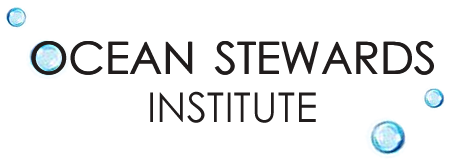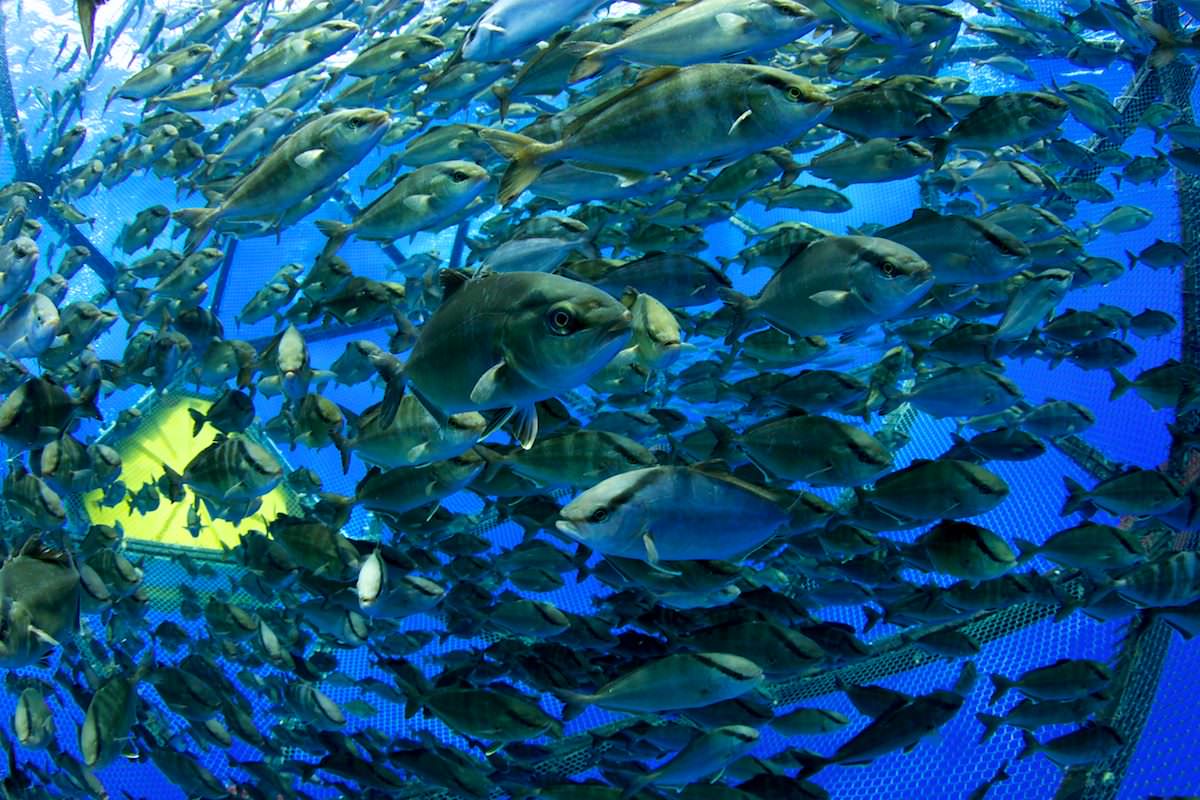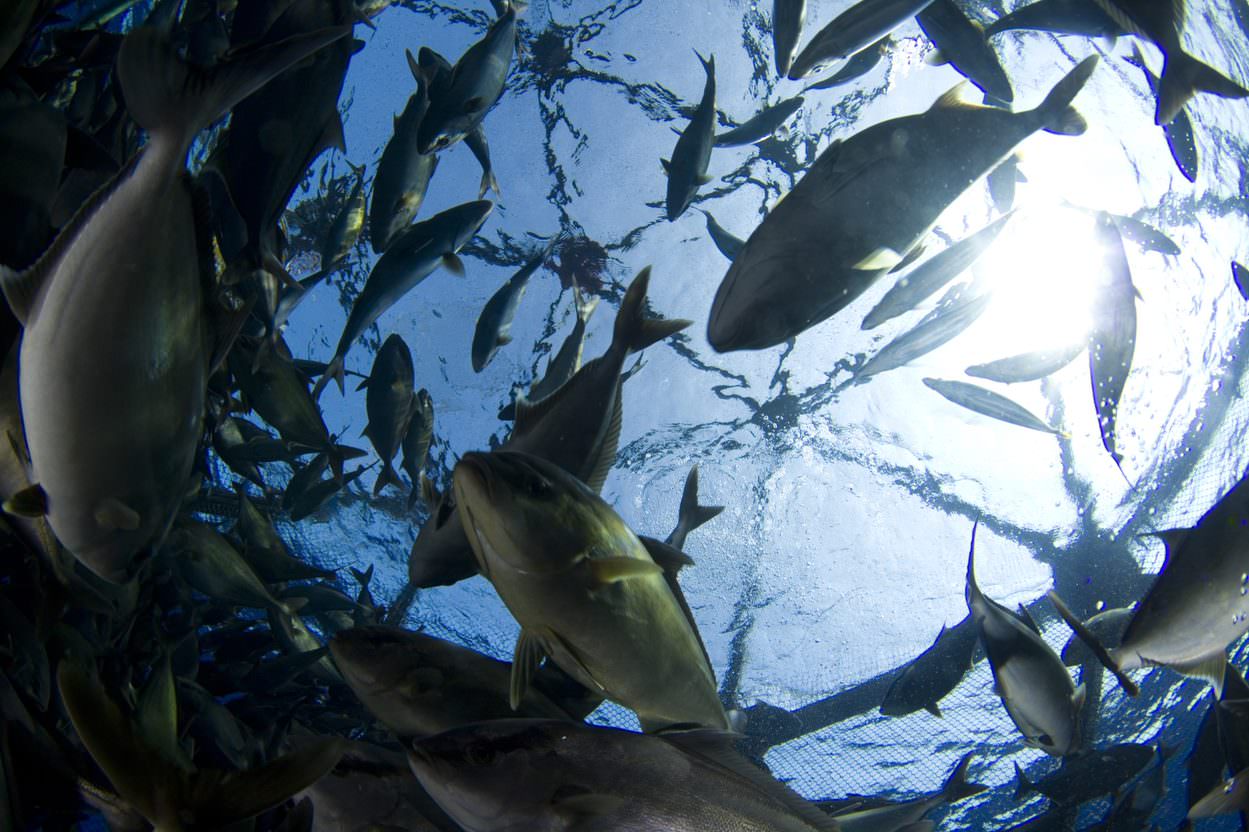What, then, must we do? An open letter, and a challenge.
Article originally printed in Aquaculture Magazine December 2018/January 2019 Volume 44 Number 6
Deployment of offshore fish cage, Kampachi Farms’ Velella project.
Shortly prior to his untimely defenestration (i.e. being tossed out the window), the character of conscience in the movie “The Year of Living Dangerously” becomes so frustrated with the injustices of the 1960’s Indonesian socio-economic imbalances to which he bears witness, that he compulsively, obsessively pounds this question repeatedly into his typewriter:
“What, then, must we do?!
What, then, must we do?!”
We proponents of offshore aquaculture in US Federal waters might also ask the same question, in the same tone of righteous indignation, as we survey the public policy landscape in which we find ourselves. But we might also ask the same question of the so-called conservation community, in the face of their perennial failure* to accept the overwhelming scientific consensus that aquaculture is an absolutely essential element of any future sustainable world, and that offshore aquaculture probably represents the least impactful means of significantly expanding global seafood production.
* - aside from Conservation International, The Nature Conservancy and WWF, who see the light and – to varying degrees - embrace offshore aspirations.
———
The recent Louisiana court decision effectively torpedoed the last ten or more years of NOAA’s efforts to move forward with offshore aquaculture in the Gulf of Mexico, and elsewhere. Well, yes, one might argue that this simply removes one more onerous obligation; any offshore aquaculture applicant will still require an NPDES permit from EPA, and a Section 10 Permit from Army Corps (to which NOAA would be a party), and US Coast Guard sign-off, and certification by the nearest coastal state of the project’s compliance under the Coastal Zone Management Act. But Judge Triche Milazzo’s decision simply underscored the need for regulatory clarity in US offshore aquaculture.
Senator Wicker of Mississippi has proposed legislation that would fill this vacuum, which seems to offer a platform whereby reasonable people might agree. And yet, the halls of Congress have, as of writing, been bereft of anyone with any notable green credibility who might endorse this draft … or even who might invite any discussion.
What, then, must we do?!
This is what we first ask of ourselves. What other evidence can we provide? What additional study is needed to break through the entrenched eNGO mindset? There is already an abundance of sound science that affirms the need for expansion of offshore aquaculture. Continued opposition to – or indifference to – this position is the environmental equivalent of supporting expansion of coal-fired power plants; it is the socio-economic equivalent of advocating for more condos along America’s waterfront; and it is the public-health equivalent of promoting more smoking of cigarettes.
Offshore cage of kampachi (Seriola rivoliana). PC: Bryce Groark.
Hyperbole, you ask? Consider the following …
From the planetary perspective, it is abundantly clear that there is insufficient land, fresh water and feedstuffs to sustain 9 billion people hankering for hamburgers at the rate that Americans currently consume cow-flesh. Further, methane and nitrous-oxide-belching bovines represent a significant component of global GHG emissions. On our current trajectory, earth’s atmosphere will be rendered more like Venus, and our soils more like Mars.
We cannot mandate vegetarianism, and so the best way that these critical constraints can be avoided is for attractive protein alternatives to be available and affordable. And no, that does not mean carp or tilapia. I do not know anyone who walks into a sushi bar and orders tilapia. No-one sits down in a steak-house and orders carp. It has to be fillets of tantalizingly tasty marine fish, or the billions will want to be buying the beef.
Kampachi sashimi.
Roasted kampachi.
The Blue Frontiers study of 2011 (which was the pivotal expose on all the above) now bookends very nicely with the Froehlich, et al., study of 2018, which used marine spatial planning models to project that offshore aquaculture, sited only in under-utilized ocean space out to the 200 m isobath, could produce more than 100 times the current level of global seafood consumption. With 100 times the seafood availability, in marine fish, bivalves and algae (or even with just 3x or 4x), perhaps we could begin to restore some of the overworked terrestrial ecosystems by increasing land devoted to conservation. Isn’t that what a conscious environmentalist should support?
Many of the marine-focused NGOs also support maintaining working waterfronts. This, too, can be achieved through offshore aquaculture, alongside commercial fishing. Commercial fishermen readily comprehend this: in Kampachi Farms’ SeaGrant-supported project for a demonstration net pen offshore of Florida, we have been flooded with offers from commercial fishermen to provide dock-space, processing facilities, or boats for lease. These same fishermen also immediately understand the benefits to their bottom line of the FAD effects of an offshore array (which makes it exceedingly curious that commercial, charter-boat and recreational fishermen signed on to the Louisiana lawsuit). And US seafood distributors and processors are among the Stronger America Through Seafood coalition that is ardently supportive of Wicker. They understand the importance of keeping seafood jobs in America – something the eNGOs also claim to support.
Inside view of Kampachi Farms’ offshore Velella cage.
There is now an abundance of accumulated environmental science that unequivocally dispatches the eco-hand-wringing that was previously used to besmirch net pen aquaculture. The best distillation of these data can be found in Price and Morris (2013), and Rust, et al., (2014). The former meta-analysis of studies on water quality and benthic impacts around net pens concluded that so long as basic, common-sense siting criteria are adopted, then there is no significant impact, and often no measureable impact whatsoever. The latter study of other ecosystem impacts from net pens in US State waters concluded that so long as basic Best Management Practices (BMPs) are employed, then there is no significant impact from net pen operations on wild fish genetics or wild fish stock abundance, on marine mammal populations or other components of marine ecosystems.
In terms of public health, the irrefutable facts espoused by Mozaffarrian and Rimm (2006) stand unchallenged. If Americans doubled their consumption of oily seafood, to a mere two meals per week, then this would result in a 34% reduction in deaths from heart disease, and a 17% reduction in mortality overall. A 17% reduction in mortality stands roughly equivalent to seatbelts and smoking, in terms of a public health imperative! Americans should be eating way more seafood. Why aren’t they?
Mostly because they are scared of eating farmed fish. Much of the anti-aquaculture messaging around salmon farming over the last two decades was founded in fearmongering over the purported health risks from mercury or PCBs. And so American consumers linger over the seafood counter, their minds toying with an alluring fillet of farmed fish … but then the claxon-horn alarm sounds in their ears (“Mercury! PCBs!”), and they do, at that moment, the worst thing possible for their health – they turn around and choose the farmed beef.
Kampachi sashimi.
These food safety myths persist, reverberating around the internet and around restaurant tables, and so even though the science is compelling, American seafood consumption is stalled around a pathetic 14 pounds per annum. With the failure of eNGOs to embrace aquaculture, or through their persistently tepid acceptance of its advent, these public health misperceptions linger, uncorrected. And so heart disease rates remain a tragic 25% of American mortality. This could be corrected – simply and convincingly - if the leading eNGOs came forward and asserted that farmed fish was what really should be for dinner.
What, then, must we do?! This is also a question that the eNGOs, and all of the individuals who work for them, must ask of themselves. Surely, these organizations, and these people, place their faith in science, yes? These are the same individuals who rail against the climate-deniers, berating them for ignoring the preponderance of evidence of the human components underpinning global climate change. And yet, it seems that they choose to ignore the science around aquaculture.
So, then, this is one thing that we must do: We must challenge the eNGO community with this question. “If you acknowledge this accumulated evidence, then how can you remain silent?” If they still refuse to change their attitudes to aquaculture, in the face of all that has been shown, then they are denying a salve for that which most ails the earth; they are undermining gainful employment in the seafood sector; and they are letting people die, by contributing to mortality rates that could be significantly reduced by consumption of more seafood.
This is a moral imperative, and we should begin to present it as such. It has very real consequences. So long as there is no conservation community support for aquaculture in US Federal waters, then there will be no Democratic endorsement of the Wicker Bill. And without bipartisan support, then it is hard to imagine this legislation moving forward. Without the bill, then it is highly unlikely that there will be farms in US waters. Without offshore aquaculture, then our weary world, our eroding waterfronts, and our grandchildren will all share that loss.
———
Despite appearances, the above was not intended to be solely for the satisfaction of venting my spleen. It was a genuine attempt to ask an honest question. And so perhaps – rather than an article – we might consider this as an open letter. As such, please ignore the copyright restrictions that might normally accompany an esteemed publication such as this. Please do scan this article and email it, or tear it out of your copy of Aquaculture Magazine and mail it, to any friends or associates that you might know who are working in the marine conservation field. Please press them to answer these few questions:
What, then, must we do? What else can we, as offshore aquaculture advocates, provide that will ease their anxieties, or help persuade them of the imperative of our position?
And then press them to ask themselves: What, then, must I do? What should a moral, science-driven individual or organization do, in the face of this evidence?
As the adage urges, we must think globally, but we must act locally. But we must also do it all honorably, and honestly. How will each of us answer the question … perhaps the greatest challenge of our time?







